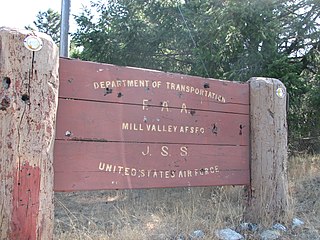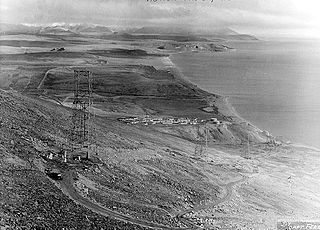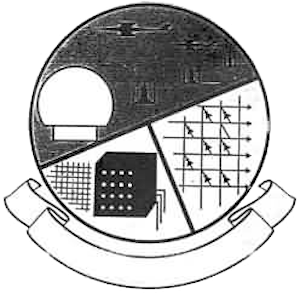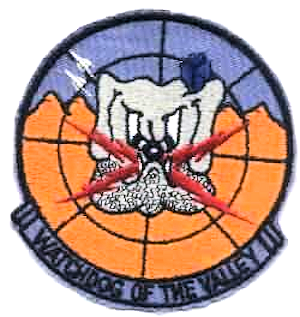
Ground Equipment Facility J-33 is a Federal Aviation Administration (FAA) radar station of the Joint Surveillance System's Western Air Defense Sector (WADS) with an Air Route Surveillance Radar (ARSR-4). The facility was previously a USAF general surveillance radar station during the Cold War.

The United States Air Force's 505th Command and Control Wing is organized under the United States Air Force Warfare Center. The wing is dedicated to improving readiness through integrated training, tactics development and operational testing for command and control of air, space and cyberspace. It hosts the Air Force's only Air Operations Center Formal Training Unit at Hurlburt Field, Florida.

Tatalina Air Force Station is a closed United States Air Force General Surveillance Radar station. It is located 13 miles (21 km) west-southwest of McGrath, Alaska.

The 16th Airborne Command and Control Squadron was a United States Air Force squadron assigned to Air Combat Command's 461st Air Control Wing, 461st Operations Group, stationed at Robins Air Force Base, Georgia. The squadron previously flew the Northrop Grumman E-8C JSTARS, providing airborne battle management, command and control, surveillance, and target acquisition with the last E-8C flight on September 8, 2022.

Tin City Long Range Radar Site is a United States Air Force radar station. It is located 106.3 miles (171.1 km) west-northwest of Nome, Alaska. It is the former Tin City Air Force Station.

Cross City Air Force Station is a former United States Air Force facility, located 1.6 miles (2.6 km) east of Cross City, Florida.

Murphy Dome Air Force Station is a closed United States Air Force General Surveillance Radar station 20.4 miles (32.8 km) west-northwest of Fairbanks, Alaska.

Aiken Air Force Station is a closed United States Air Force General Surveillance Radar station. It is located 6.4 miles (10.3 km) north-northeast of Aiken, South Carolina. It was closed in 1975.
Bedford Air Force Station is a closed United States Air Force General Surveillance Radar station. It is located 12.7 miles (20.4 km) north of Bedford, Virginia. It was closed in 1975.
Palermo Air Force Station is a closed United States Air Force (USAF) General Surveillance Radar station. It was located in Palermo, New Jersey, 4.8 miles (7.7 km) north of Sea Isle City, in Cape May County, New Jersey, United States. It was closed in 1970.

Hanna City Air Force Station is a closed United States Air Force General Surveillance Radar station. It is located 1.6 miles (2.6 km) west-northwest of Hanna City, Illinois. It was closed in 1968. It is still in use by the Federal Aviation Administration as a Joint Surveillance System radar station.
Wadena Air Force Station is a closed United States Air Force General Surveillance Radar station. It is located 7 miles (11 km) north-northeast of Wadena, Minnesota. It was closed in 1970.
Cambria Air Force Station is a closed United States Air Force General Surveillance Radar station. It is 3 miles (4.8 km) south-southeast of Cambria, California. It was closed in 1980.

Madera Air Force Station is a closed United States Air Force General Surveillance Radar station. It is located 5.2 miles (8.4 km) north-northeast of Madera, California. It was closed in 1966.
Othello Air Force Station is a closed United States Air Force General Surveillance Radar station. It is located 7.2 miles (11.6 km) south of Othello, Washington. It was the home station of the 637th Aircraft Control and Warning Squadron and the 637th Air Defense Group, closing in 1975.
Houma Air Force Station is a closed United States Air Force General Surveillance Radar station. It is located 3.5 miles (5.6 km) southeast Houma, Louisiana. It was closed in 1970.
King Salmon Air Force Station is a closed United States Air Force General Surveillance Radar station. It is located 0.4 miles (0.64 km) west of King Salmon, Alaska.
Indian Mountain Air Force Station is a closed United States Air Force General Surveillance Radar station. It is located 15.8 miles (25.4 km) east-southeast of Hughes, Alaska.
Cape Lisburne Air Force Station is a closed United States Air Force General Surveillance Radar station. It is located 276.5 miles (445.0 km) west-southwest of Point Barrow, Alaska.

Kotzebue Air Force Station is a closed United States Air Force General Surveillance Radar station. It is located 4 miles (6.4 km) south of Kotzebue, Alaska.
















